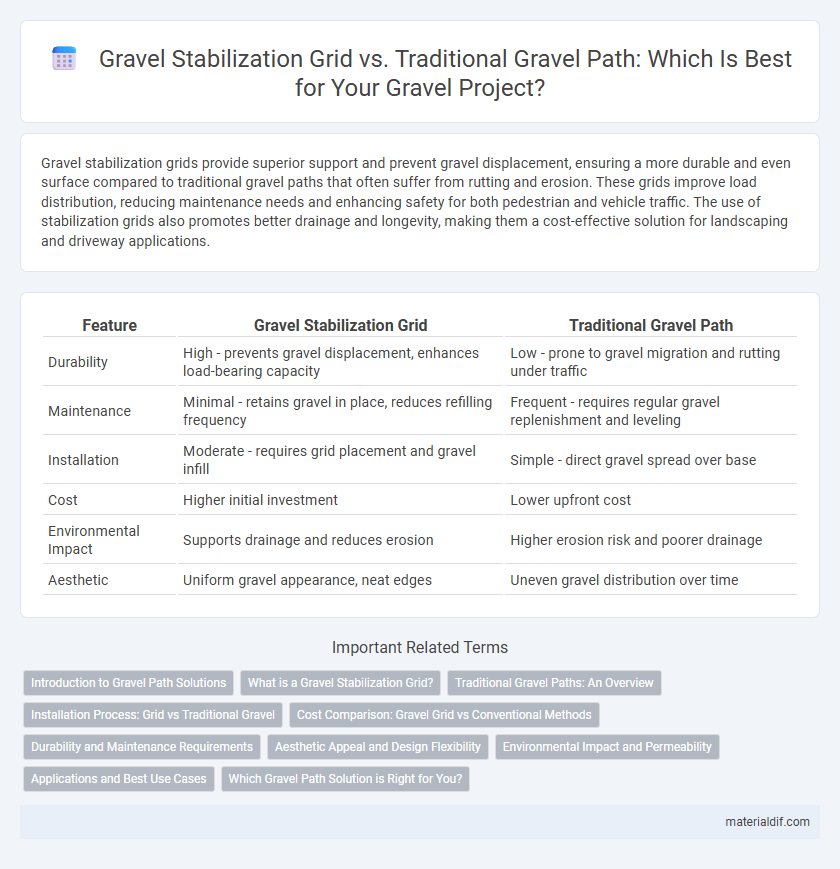Gravel stabilization grids provide superior support and prevent gravel displacement, ensuring a more durable and even surface compared to traditional gravel paths that often suffer from rutting and erosion. These grids improve load distribution, reducing maintenance needs and enhancing safety for both pedestrian and vehicle traffic. The use of stabilization grids also promotes better drainage and longevity, making them a cost-effective solution for landscaping and driveway applications.
Table of Comparison
| Feature | Gravel Stabilization Grid | Traditional Gravel Path |
|---|---|---|
| Durability | High - prevents gravel displacement, enhances load-bearing capacity | Low - prone to gravel migration and rutting under traffic |
| Maintenance | Minimal - retains gravel in place, reduces refilling frequency | Frequent - requires regular gravel replenishment and leveling |
| Installation | Moderate - requires grid placement and gravel infill | Simple - direct gravel spread over base |
| Cost | Higher initial investment | Lower upfront cost |
| Environmental Impact | Supports drainage and reduces erosion | Higher erosion risk and poorer drainage |
| Aesthetic | Uniform gravel appearance, neat edges | Uneven gravel distribution over time |
Introduction to Gravel Path Solutions
Gravel stabilization grids provide superior load distribution and erosion control compared to traditional gravel paths, reducing maintenance and preventing gravel displacement. These grids interlock with the gravel to create a stable, permeable surface ideal for driveways, walkways, and patios, enhancing durability under heavy traffic and adverse weather conditions. Traditional gravel paths lack this structural support, often leading to uneven surfaces and frequent replenishment needs.
What is a Gravel Stabilization Grid?
A Gravel Stabilization Grid is a durable, interlocking plastic or composite mesh designed to contain and support gravel, preventing displacement and erosion. Unlike traditional gravel paths that often suffer from rutting and uneven surfaces, stabilization grids distribute weight evenly, enhancing load-bearing capacity and improving drainage. This innovative solution reduces maintenance needs while providing a stable, long-lasting surface for driveways, walkways, and landscaping.
Traditional Gravel Paths: An Overview
Traditional gravel paths consist of loose, unbound stones that provide a natural and permeable surface ideal for drainage. Without stabilization grids, these paths often experience gravel displacement, rutting, and require frequent maintenance such as replenishing and leveling. Despite the upkeep, traditional gravel paths remain a cost-effective and visually appealing option for landscaping and garden walkways.
Installation Process: Grid vs Traditional Gravel
Gravel stabilization grids simplify the installation process by providing a structured base that evenly distributes weight and prevents gravel displacement, reducing labor and maintenance. Traditional gravel paths require extensive groundwork, including compaction and frequent replenishing to maintain stability and prevent erosion. The grid system offers a quicker setup with enhanced durability, making it a more efficient choice for long-lasting gravel surfaces.
Cost Comparison: Gravel Grid vs Conventional Methods
Gravel stabilization grids offer long-term cost savings by reducing gravel displacement and maintenance frequency compared to traditional gravel paths, which require frequent replenishment and grading. Initial installation costs for gravel grids are higher, but their durability and reduced material usage lower overall expenditure over time. Conventional methods often incur ongoing expenses due to erosion and washouts, making gravel grids a more cost-effective solution for pathway stabilization.
Durability and Maintenance Requirements
Gravel stabilization grids significantly enhance durability by preventing gravel displacement, reducing erosion, and maintaining structural integrity compared to traditional gravel paths that often suffer from rutting and uneven surfaces. Maintenance requirements for stabilization grids are lower due to reduced gravel loss and minimized weed growth, whereas traditional paths demand frequent replenishment and leveling. These grids provide a long-term solution, optimizing both the lifespan and upkeep efforts of gravel surfaces in high-traffic areas.
Aesthetic Appeal and Design Flexibility
Gravel stabilization grids enhance aesthetic appeal by providing a uniform, smooth surface that prevents gravel displacement and creates clean, well-defined pathways. These grids offer greater design flexibility, allowing for intricate patterns, curves, and custom shapes that are difficult to achieve with traditional loose gravel paths. The durability and consistent texture of stabilized gravel paths maintain their visual appeal over time, unlike traditional paths that often develop uneven surfaces and bare spots.
Environmental Impact and Permeability
Gravel stabilization grids significantly reduce soil erosion and runoff by maintaining gravel placement and increasing surface permeability compared to traditional gravel paths, which often suffer from displacement and compaction. These grids promote natural water infiltration, minimizing surface water pollution and reducing the risk of flooding. The enhanced permeability of stabilization grids supports groundwater recharge and decreases the environmental footprint of gravel installations.
Applications and Best Use Cases
Gravel stabilization grids provide superior load distribution and prevent gravel displacement, making them ideal for high-traffic driveways, parking areas, and pathways requiring durability and low maintenance. Traditional gravel paths are best suited for decorative garden trails or low-traffic walkways where ease of installation and cost-effectiveness are primary considerations. Selecting between stabilization grids and traditional gravel depends on the expected load, environmental conditions, and long-term maintenance needs.
Which Gravel Path Solution is Right for You?
Gravel stabilization grids provide enhanced durability and erosion control compared to traditional gravel paths, making them ideal for high-traffic areas and uneven terrain. Traditional gravel paths offer a more cost-effective solution with easier installation and maintenance, suitable for low-traffic or decorative walkways. Choosing the right gravel path depends on factors like budget, traffic volume, and landscape stability needs.
Gravel Stabilization Grid vs Traditional Gravel Path Infographic

 materialdif.com
materialdif.com